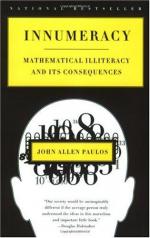
|
Introduction, Chapter 1 - Examples and Principles
• Math is frequently misused.
• Weather forecasters are often incorrect.
• Doctors often confuse percentages in predicting mortality rates/success of surgery.
• Paulos defines innumeracy.
• Math should be relatable to personal experience.
• The Archimedes Principal is discussed.
• Multiplication is examined.
• The topic of probability is raised.
Chapter 2 - Probability and Coincidence
• Paulos gives an example of a man on a plane.
• Probability is often miscalculated.
• Freud said there was no such thing as coincidence.
• Jung enjoyed synchronicity.
• People are obsessed by coincidence, irony, and synchronicity.
• Paulos investigates common coincidences.
• Winning streaks are discussed.
• People in common are examined.
• Poisson formula is introduced.
• Poisson formula is introduced.
Chapter 3 - Pseudoscience
• Paulos associates innumeracy with pseudoscience.
• Math is full of certainties.
• Uses example of Reagan.
• Educated people can be innumerate.
• Paulos introduces Fleiss and Freud.
• Uses examples.
• Paulos discusses parapsychology.
• Paulos discusses astrology.
• Author examines inaccuracy...
|
This section contains 293 words (approx. 1 page at 300 words per page) |

|




